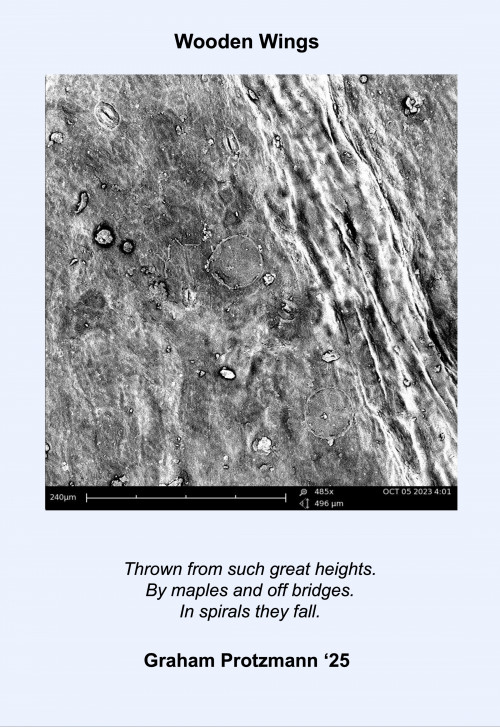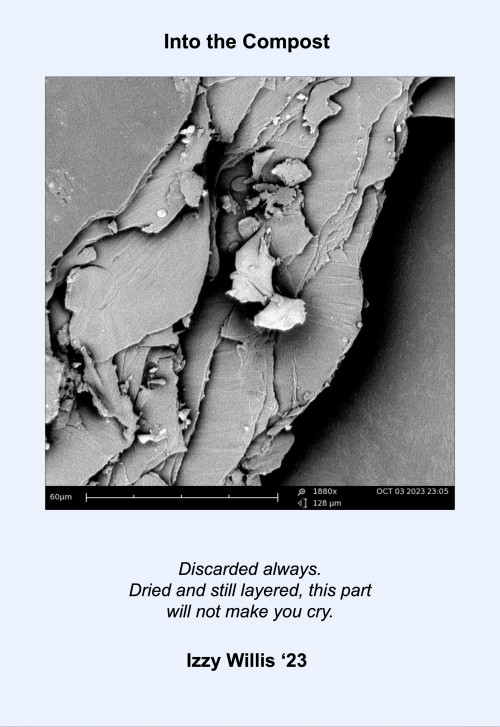NanoPoetry, a Creative Approach to Chemistry
In Nanomaterials Chemistry, a 300-level course, students’ microscopic musings become poster-worthy poetry and art.

Haiku, a centuries-old poetic form in which a writer conveys expansive meaning in only 17 syllables, might seem like an unusual topic for a Nanomaterials Chemistry assignment. But students in CHEM 361—which draws both chemistry majors and nonmajors—find the smallest of poems the perfect way to describe what they discovered through electron microscopy.
-
 Microscopic sample: ground Gesha coffee from Gesha Village, Ethiopia
Microscopic sample: ground Gesha coffee from Gesha Village, Ethiopia -
 Microscopic sample: seed pod from the honey locust tree outside Olin Center
Microscopic sample: seed pod from the honey locust tree outside Olin Center
The opportunity to view everyday materials at the nano level can be awe-inspiring, as students discovered when they examined a variety of organic and inorganic samples under Lewis & Clark’s electron microscope. While conventional microscopes rely on visible light focused with lenses to magnify samples, the electron microscope aims a beam of electrons, focused with magnets, at a sample, creating images from the electrons that bounce back.
-
 Microscopic sample: salt
Microscopic sample: salt -
 Microscopic sample: maple tree "helicopter"
Microscopic sample: maple tree "helicopter"
“Seeing so many things up close through the scanning electron microscope gave me more perspective on how much surface area can be on something that appears smooth,” noted chemistry major Owen Beale BA ’24. Beale explained that those surfaces have important implications, because “reaction rates in chemistry can be greatly affected by surface area.” Even “something that appeared pretty smooth, like a black tea leaf, could have so many fibers, nooks, and crannies on the surface.”
-
 Microscopic sample: black tea leaf
Microscopic sample: black tea leaf -
 Microscopic sample: Peet’s Major Dickason’s Blend pre-ground coffee
Microscopic sample: Peet’s Major Dickason’s Blend pre-ground coffee
Regardless of major, the students agreed that organic matter, which has less uniform surfaces than inorganic matter, was visually stunning as well as scientifically interesting to examine at the nano level. Each student chose a particularly compelling image and crafted a haiku inspired by what they observed.
For Makena Andersen BA ’24, a chemistry and physics double major, inspiration came from an artificial plant in the science building lounge: a spider had died in the plant, providing an organic sample to examine. Working with the microscope, Andersen focused on the hair along the spider’s legs. Andersen isn’t the first L&C student to study the importance of arachnid’s hirsute limbs, but their poem celebrating the power of this spider’s leg hair offered a new way to share scientific findings with the broader community.
-
 Microscopic sample: spider leg
Microscopic sample: spider leg -
 Microscopic sample: onion skin
Microscopic sample: onion skin -
 Microscopic sample: $1 bill
Microscopic sample: $1 bill
Anne Bentley, Dr. Robert B. Pamplin Jr. Associate Professor of Science, designed the assignment so that students could share their explorations of electron microscopy and nanomaterials with other members of the L&C community. She always welcomes students from a variety of majors to enroll in the course. The posters combining students’ poems with the microscope images that inspired them, on view in the Olin Center for Physics and Chemistry, provide an artistic way to inspire other undergraduates to explore nanomaterials chemistry.
More Stories

Sneaker Law
Stepping Into a New Era of Legal Education
Sports and entertainment attorney Nic Mayne teaches a new Sneaker Law course at Lewis & Clark Law School, providing hands-on contract drafting experience through the lens of the athletic footwear industry.

Climate Change
New Scholarship for International Environmental Law LLM Students
The Karuna Foundation recently funded a new scholarship for students from the Himalayan region. The scholarship—the first of its kind for the environmental program—will provide significant funding for an international student with a passion for environmental law and climate change mitigation.

Prosperous Portland
An L&C Leader for Portland’s Small Business Community
Lewis & Clark’s Entrepreneur in Residence Mitch Daugherty has been tapped to lead Portland’s newly created Office of Small Business, helping to connect small business owners with the resources they need to thrive.

Beyond Divisions
21st Annual Ray Warren Symposium Explores the Concept of Borders
This year’s Ray Warren Symposium on Race and Ethnic Studies, held November 13-15, is titled On the Border. It will examine the different borders we experience, the role of borders in our lives, and the relationship between borders and ideas of race and ethnicity.
